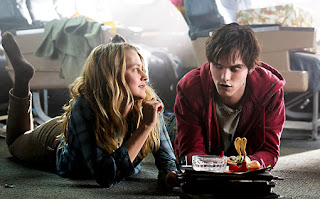Warm Bodies
Warm Bodies is a 2013 American paranormal romantic zombie
comedy film based on Isaac Marion's novel of the same name. Directed and
written by Jonathan Levine,[6] the film stars Nicholas Hoult, Teresa Palmer and
Analeigh Tipton.
The film focuses on the development of the relationship
between Julie, a young woman, and "R", a zombie, and how their
eventual romance develops throughout. The film is noted for displaying human
characteristics in zombie characters, and for being told from a zombie's perspective.
After a zombie apocalypse, R, a zombie, spends his days
wandering around an airport which is now filled with hordes of his fellow
undead, including his best friend M. R and M achieve rudimentary communication
with grunts and moans and occasional near-words. As a zombie, R constantly
craves human flesh, especially brains, as he is able to "feel alive"
through the victims' memories he experiences when he eats them. While R and a
pack of zombies are out hunting for food, they encounter Julie Grigio and a
group of her friends, who were sent out by Julie's father from a
heavily-fortified, walled-off human enclave in a nearby city to recover medical
supplies from abandoned buildings. R sees Julie and is drawn to her. After
being shot in the chest by Julie's boyfriend, Perry, R kills him while Julie is
distracted, and eats his brain, giving R his thoughts and memories, making his
attraction to Julie even stronger. He rescues Julie from the rest of the pack
and takes her back to an airplane he lives in at the airport to keep her safe.
The two bond, causing R to slowly begin to come to life.[9] After a few days,
Julie gets restless, and tries multiple times to return home, yet attracts
swarms of zombies every time, requiring R to rescue her. After fending off a
group of zombies, including M, who is confused by R's actions, R decides it is
time to return her to the human enclave.
On the way, R reveals to Julie that he was the one that
killed Perry, which prompts her to abandon him and return alone to the human
enclave. R begins to make his way back to the airport, heartbroken. He then
sees that M and other zombies are also beginning to show signs of life, making
all of them targets for the Boneys, skeletal zombies who having lost all traces
of their humanity have shed their flesh, and prey on anything with a heartbeat.
R and M lead a group to the human enclave, where R sneaks inside the wall.
There he finds Julie and meets her friend Nora, who is initially shocked. When
R reveals that the other corpses have also been coming back to life, the three
of them attempt to tell Colonel Grigio, Julie's father and leader of the
survivors. Colonel Grigio, however, refuses to believe corpses can change and
threatens to kill R, stopping only when Nora pulls a gun on him. Julie and R
escape to a baseball stadium where the rest of R's group is waiting, but find
themselves under attack by a horde of Boneys.
While M and his gang of zombies square off against the
Boneys, Julie and R run, but find themselves trapped. Taking the only escape
route, R jumps with Julie into a pool far below, shielding her from the impact.
After Julie pulls R from the bottom of the pool, they kiss passionately -
causing R to become fully revived. Colonel Grigio finds them soon after,
shooting R in the shoulder without warning, and when R bleeds, is finally
convinced that he has returned to life. The humans and zombies combine forces and
kill most of the Boneys while the rest die off, and the zombies slowly
assimilate into human society. The film ends with a now fully alive R and Julie
watching a wall surrounding the city being demolished, signifying the end of
the apocalypse.
Cast
Nicholas Hoult as R
Teresa Palmer as Julie Grigio
Rob Corddry as M / Marcus, a friend of R
Dave Franco as Perry Kelvin, Julie's boyfriend
Analeigh Tipton as Nora, a friend of Julie
Cory Hardrict as Kevin
John Malkovich as Colonel Grigio, Julie's father and leader
of the human survivors











.jpg)
.jpg)
.jpg)

.jpg)
.jpg)




.jpg)
.jpg)


.jpg)






.jpg)
.jpg)
.jpg)
.jpg)
.jpg)
.jpg)

.jpg)









.jpg)


